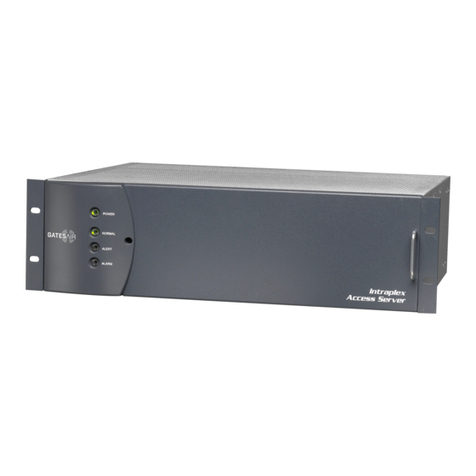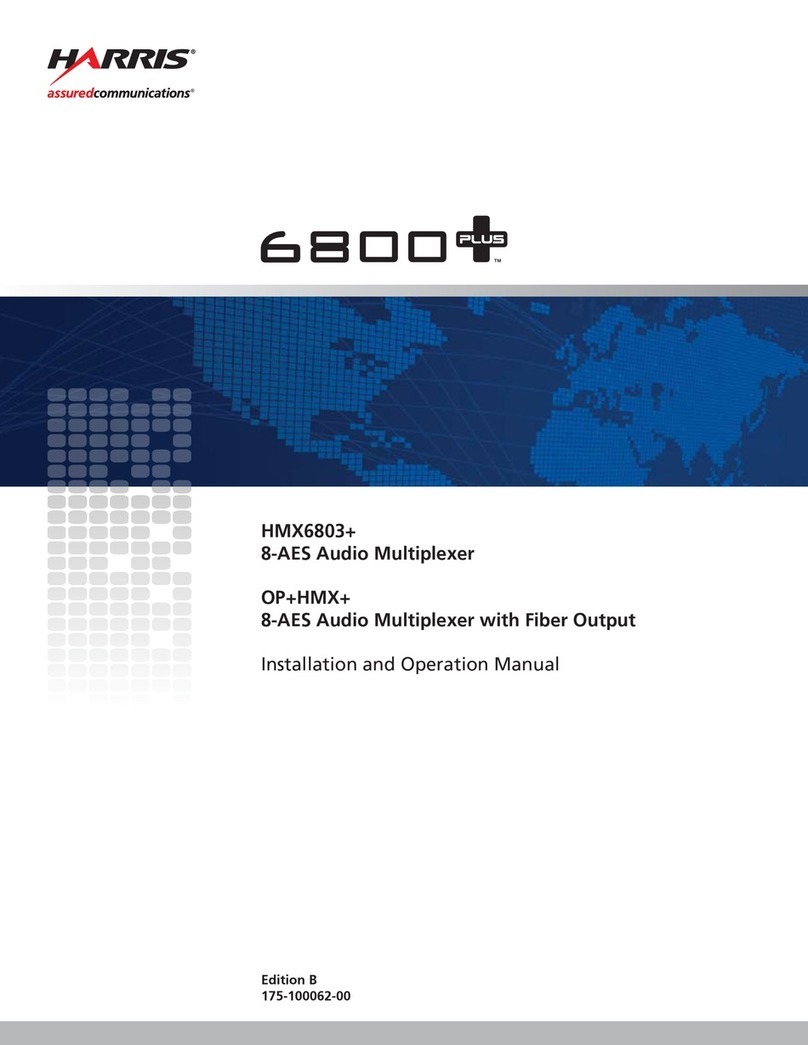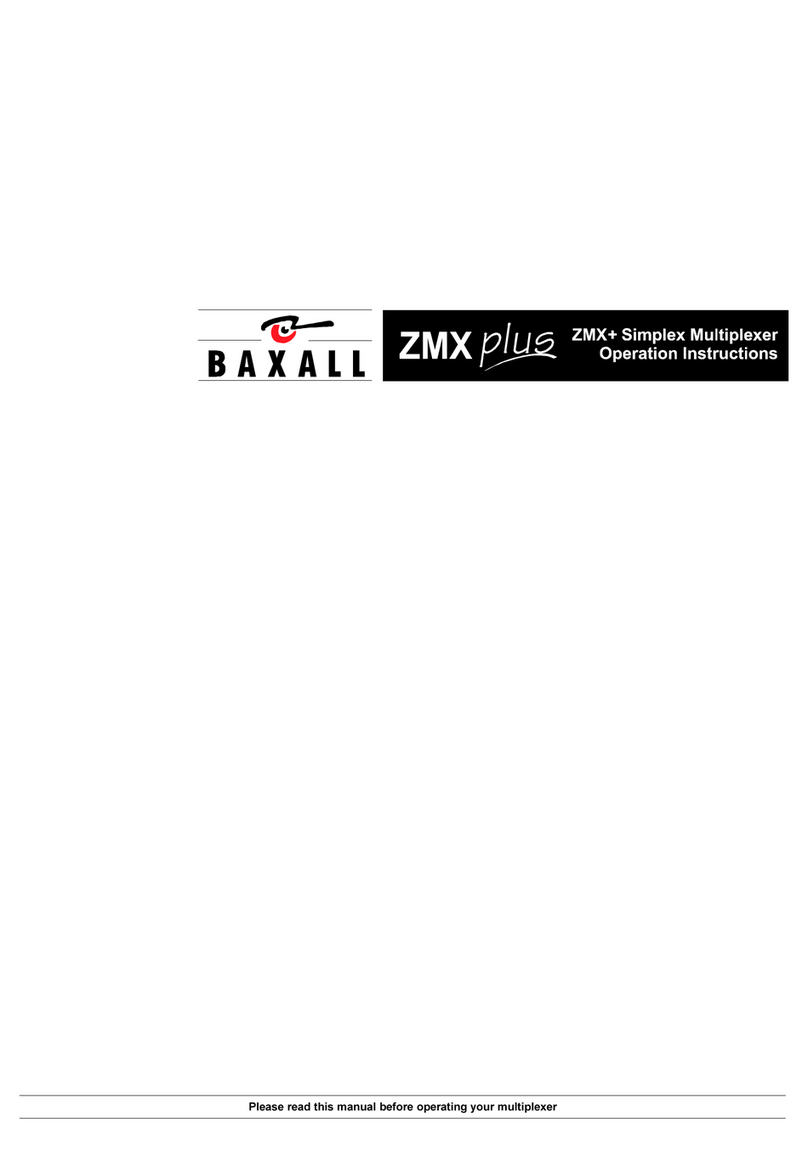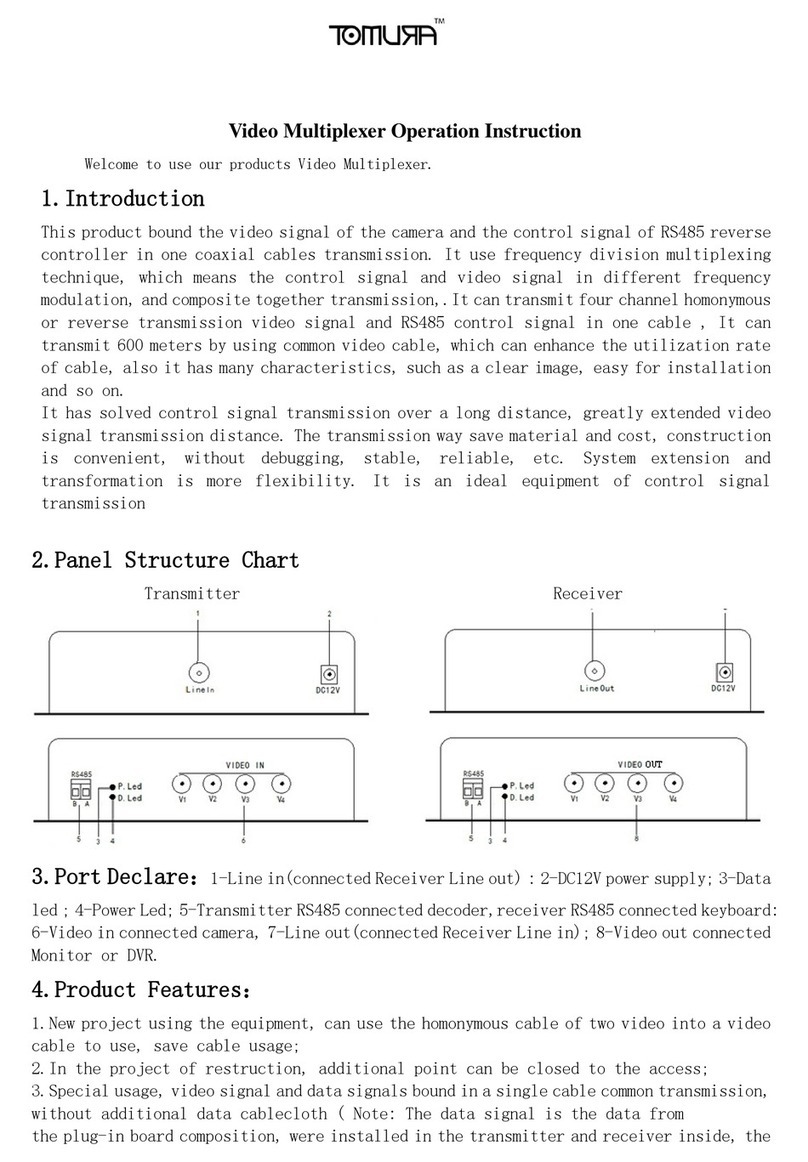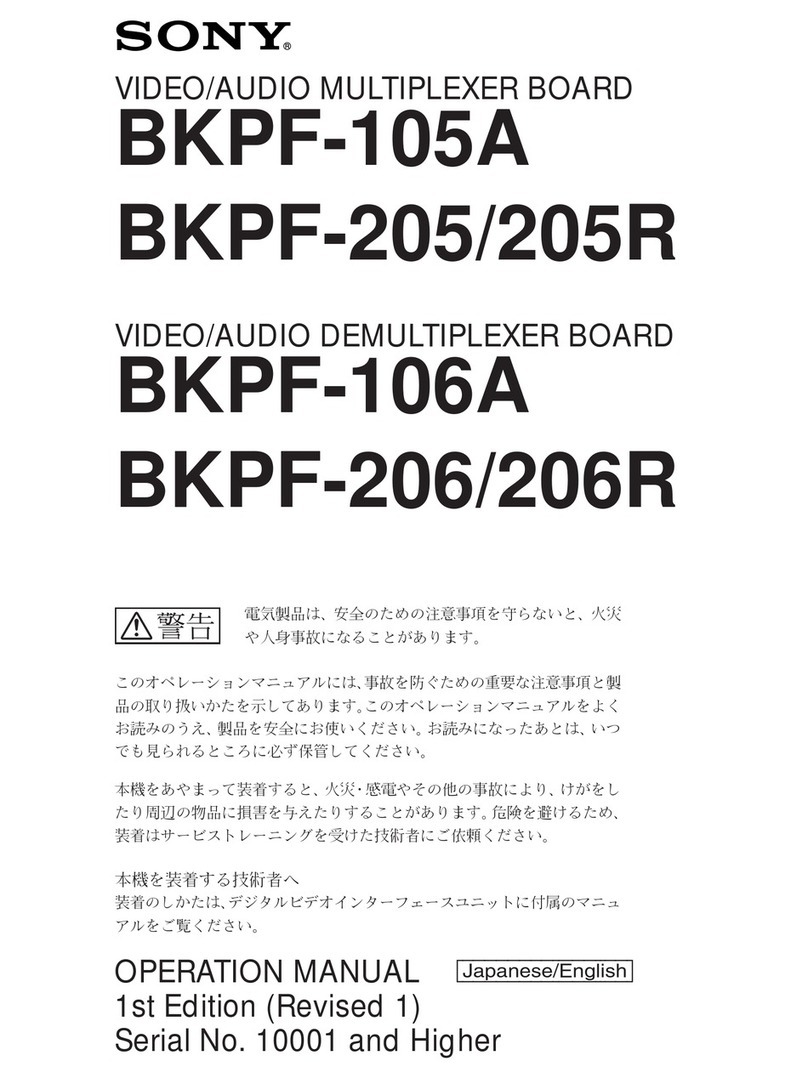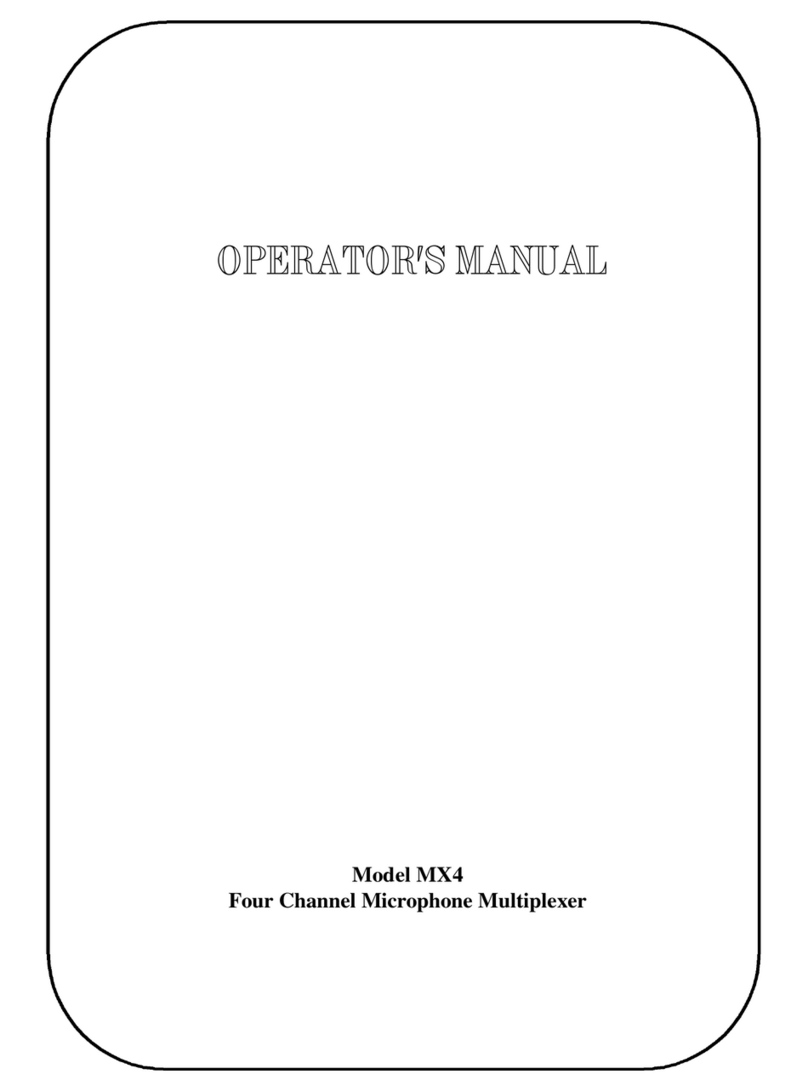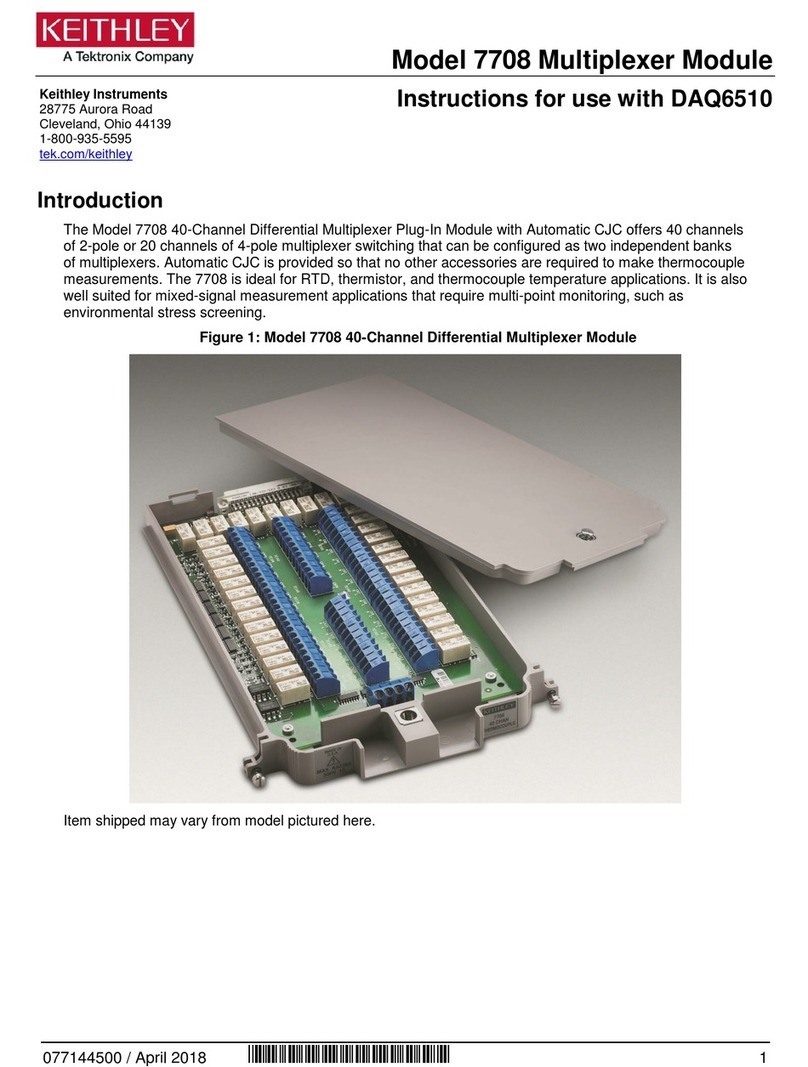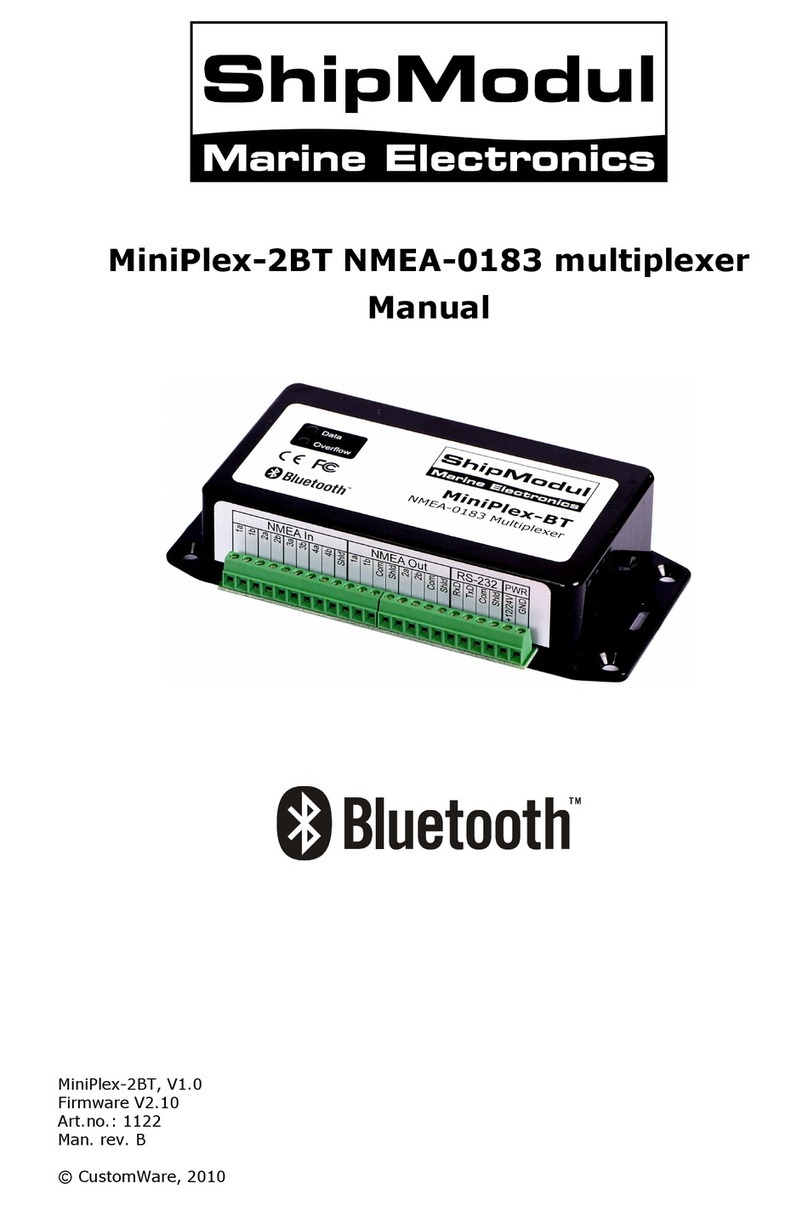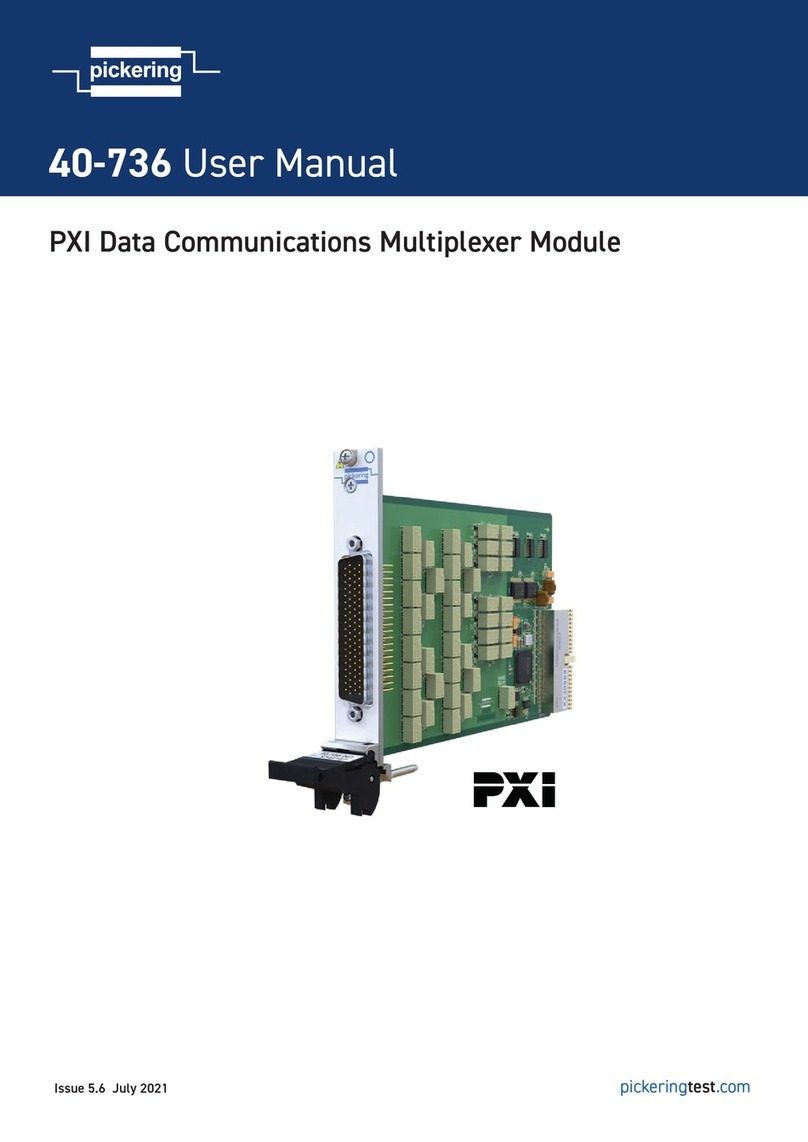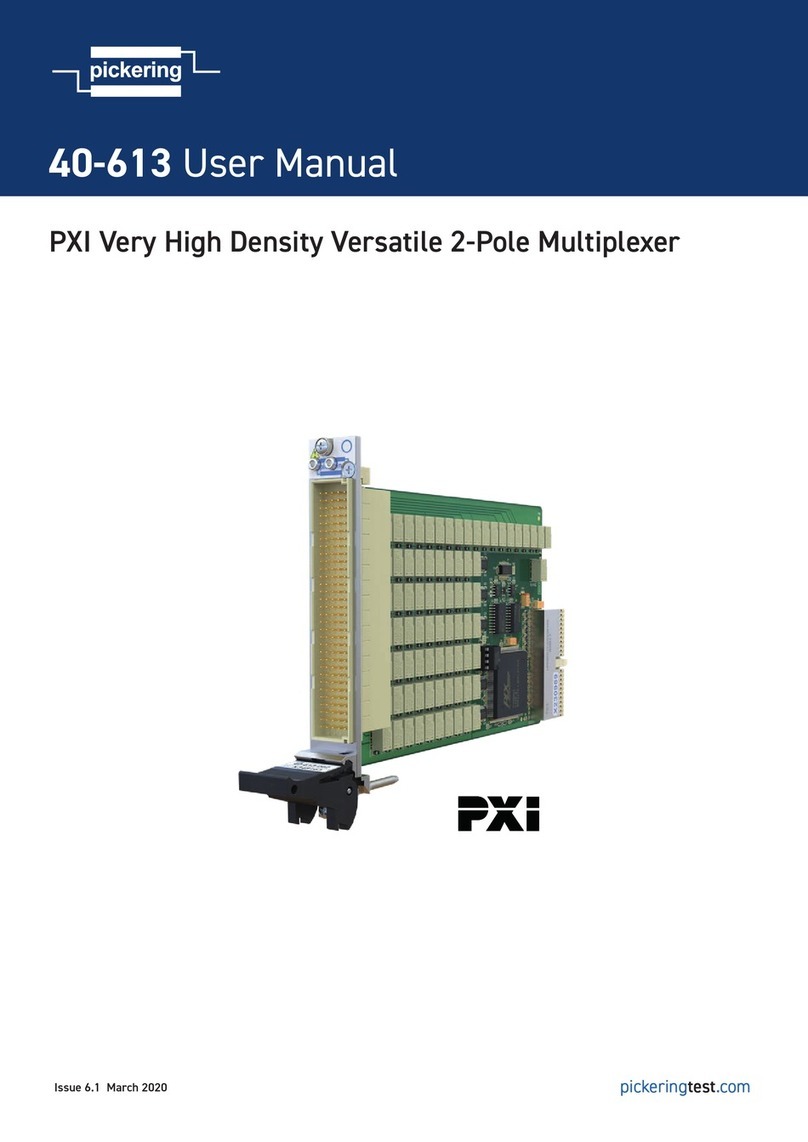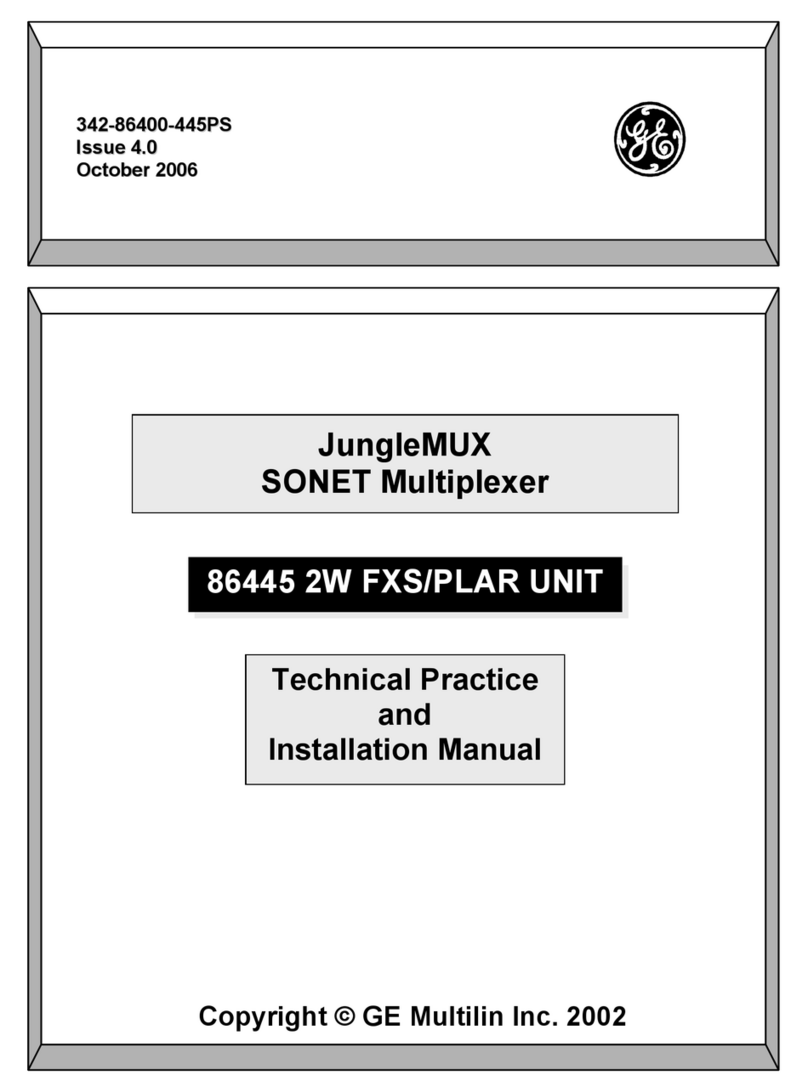Harris SELENIO SEL-MDX1-EES User manual

Edition A
175-100267-00
MDX1
MPEG-2 Transport Stream
Multiplexer/Demultiplexer
Installation and Operation Manual
D
F


SEL-MDX1
MPEG-2 Transport Stream
Multiplexer/Demultiplexer
Installation and Operation Manual
Edition A
March 2011

Harris Corporation
Broadcast
Communications
Division
4393 Digital Way
Mason, OH USA
45040
Copyright © 2011, Harris Corporation, 1025 West NASA Boulevard, Melbourne, Florida 32919-0001 U.S.A. All
rights reserved. This publication supersedes all previous releases. No part of this documentation may be reproduced
in any form or by any means or used to make any derivative work without permission from Harris Corporation.
Harris Corporation reserves the right to revise this documentation and to make changes in content from time to
time without obligation on the part of Harris Corporation to provide notification of such revision or change.
UNITED STATES GOVERNMENT LEGEND Ifyou are a United States government agency, then this
documentation and the software described herein are provided to you subject to the following:
All technical data and computersoftware are commercial in nature and developed solely at private expense.
Software is delivered as “Commercial Computer Software” as defined in DFARS 252.227-7014 (June 1995) or as a
“commercial item” as defined in FAR 2.101(a) and as such is provided with only such rights as are provided by
Harris’ standard commercial license for the Software. Technical data is provided with limited rights only as provided
in DFAR 252.227-7015 (Nov 1995) or FAR 52.227-14 (June 1987), whichever is applicable. You agree not to
remove or deface any portion of any legend provided on any licensed program or documentation contained in, or
delivered to you in conjunction with, this User Guide.
This publication, or any part thereof, may not be reproduced in any form, by any method, for any purpose, without
the written consent of Harris Corporation.
Contact Harris Corporation for permission to use materials as well as guidelines concerning foreign language
translation and publication.
Harris Corporation reserves the right to revise and improve its products as it chooses. This publication is designed
to assist in the use of the product, as it exists on the date of publication of this manual, and may not reflect the
product at the current time or an unknown time in the future. This publication does not in any way warrant
description accuracy or guarantee the use for the product to which it refers.
The Harris logo and assured communications are registered trademarks of Harris Corporation. D-Series is a
trademark of Harris Corporation. All other trademarks are held by their respective owners.
This user guide was created for the Selenio SEL-MDX1, Edition A.
Windows is a registered trademark of Microsoft Corporation. AMD and Operton are trademarks of Advanced
Micro Devices, Inc. Dolby and the double-D symbol are registered trademarks of Dolby Laboratories. Java is a
trademark of Sun Microsystems, Inc. or its subsidiaries in the United States and other countries.
All other trademarks are the property of their respective holders.
Publication Date: March 2011

iii
Copyright © 2011, Harris Corporation
Contents
Preface..........................................................................................................................v
Manual Information .......................................................................................................v
Purpose ......................................................................................................................v
Audience ....................................................................................................................v
Revision History ..........................................................................................................v
Writing Conventions ...................................................................................................v
Obtaining Documents ................................................................................................ vi
Unpacking/Shipping Information ................................................................................ vi
Unpacking a Product .................................................................................................vi
Product Servicing .......................................................................................................vi
Returning a Product ...................................................................................................vi
Safety Standards and Compliances ............................................................................ vii
Restriction on Hazardous Substances (RoHS) Compliance .......................................... vii
Waste from Electrical and Electronic Equipment (WEEE) Compliance ......................... vii
Safety Terms and Symbols in this Manual ................................................................ viii
Installation, Operation, and Specifications............................................. 1
Overview ....................................................................................................................... 1
Main Features ................................................................................................................ 1
Front Module ................................................................................................................. 3
Back Modules ................................................................................................................ 4
Modules and Options ................................................................................................... 5
Signal Flow .................................................................................................................... 6
Installing MDX1 Modules ............................................................................................. 7
Removing Selenio Modules .......................................................................................... 8
Front Module ............................................................................................................ 8
Back Module ............................................................................................................. 8
Powering Up a Module ................................................................................................. 9
Upgrading Module Firmware ....................................................................................... 9
Upgrade Failure Instructions ...................................................................................... 9
Parameter Descriptions .............................................................................................. 10
Module Name Block .................................................................................................... 10
Name ...................................................................................................................... 10
Function Map .............................................................................................................. 10
Type ........................................................................................................................ 10
Demux PID Map .......................................................................................................... 11
IP LANs ......................................................................................................................... 11
Primary and Secondary Data IP LANs ........................................................................ 11
Time to Live ............................................................................................................. 12
Primary and Secondary Data Eth MAC ..................................................................... 12
Data Eth Protection ................................................................................................. 12

SEL-MDX1
Installation and Operation Manual
iv
Copyright © 2011, Harris Corporation
Selected Data Eth Interface ......................................................................................12
Multiplexers .................................................................................................................13
Input Channels ........................................................................................................ 14
DVBT Transmitter .....................................................................................................16
General .................................................................................................................... 16
................................................................................................................................19
IP Destinations .........................................................................................................19
DVB ......................................................................................................................... 19
DVBT .......................................................................................................................20
Output TS Status ......................................................................................................20
Output IP Status .......................................................................................................20
Carousel Status ........................................................................................................ 20
Demultiplexers ............................................................................................................21
General .................................................................................................................... 21
IP Source ..................................................................................................................22
Input TS Status .........................................................................................................22
Input IP Status ..........................................................................................................23
Output Channels .....................................................................................................23
FEC .......................................................................................................................... 24
Demultiplexer PID Map ............................................................................................25
Conditional Access System .........................................................................................25
Vendor and CA Systems ID ...................................................................................... 25
ECMG ......................................................................................................................26
EMMG .....................................................................................................................26
Access Criteria .........................................................................................................26
Conditional Access SCG 1-240 .................................................................................... 27
Multiplexer ..............................................................................................................27
Crypto Period ...........................................................................................................27
ECM ........................................................................................................................ 27
Reference Clock ...........................................................................................................28
Specifications ............................................................................................................... 29
ASI Input and Output Specifications .........................................................................29
SMPTE 310M Input and Output Specifications ......................................................... 30
Reference Clock ...........................................................................................................30
Index...........................................................................................................................31

v
Copyright © 2011, Harris Corporation
Preface
Manual Information
Purpose This manual details the features, installation, operation, maintenance, and specifications for
the Selenio SEL-MDX1 MPEG-2 Transport Stream Multiplexer/Demultiplexer.
Audience This manual is written for engineers, technicians, and operators responsible for installation,
setup, maintenance, and/or operation of the Selenio SEL-MDX1 MPEG-2 Transport Stream
Multiplexer/Demultiplexer.
Revision
History
Writing
Conventions
To enhance your understanding, the authors of this manual have adhered to the following
text conventions:
Table 2-1 Revision History of Manual
Edition Date Comments
AMarch 2011 Initial release
Table 2-2 Writing Conventions
Term or
Convention Description
Bold Indicates dialog boxes, property sheets, fields, buttons, check boxes,
list boxes, combo boxes, menus, submenus, windows, lists, and
selection names
Italics Indicates E-mail addresses, the names of books or publications, and
the first instances of new terms and specialized words that need
emphasis
CAPS Indicates a specific key on the keyboard, such as ENTER, TAB, CTRL,
ALT, or DELETE
Code Indicates variables or command-line entries, such as a DOS entry or
something you type into a field
>Indicates the direction of navigation through a hierarchy of menus and
windows

SEL-MDX1
Installation and Operation Manual
vi
Copyright © 2011, Harris Corporation
Obtaining
Documents
Product support documents can be viewed or downloaded from our website. Alternatively,
contact your Customer Service representative to request a document.
Unpacking/Shipping Information
Unpacking a
Product
This product was carefully inspected, tested, and calibrated before shipment to ensure years
of stable and trouble-free service.
1Check equipment for any visible damage that may have occurred during transit.
2Confirm that you have received all items listed on the packing list.
3Contact your dealer if any item on the packing list is missing.
4Contact the carrier if any item is damaged.
5Remove all packaging material from the product and its associated components before you
install the unit.
Keep at least one set of original packaging, in the event that you need to return a product
for servicing.
Product
Servicing
Except for firmware upgrades, SEL-MDX1 modules are not designed for field servicing. All
hardware upgrades, modifications, or repairs require you to return the modules to the
Customer Service center.
Returning a
Product
In the unlikely event that your product fails to operate properly, please contact Customer
Service to obtain a Return Authorization (RA) number, and then send the unit back for
servicing.
Keep at least one set of original packaging in the event that a product needs to be returned
for service. If the original package is not available, you can supply your own packaging as
long as it meets the following criteria:
The packaging must be able to withstand the product’s weight.
The product must be held rigid within the packaging.
There must be at least 2 in. (5 cm) of space between the product and the container.
The corners of the product must be protected.
hyperlink Indicates a jump to another location within the electronic document
or elsewhere
Internet address Indicates a jump to a website or URL
NOTE: Indicates important information that helps to avoid and troubleshoot
problems
Table 2-2 Writing Conventions
Term or
Convention Description

SEL-MDX1
Installation and Operation Manual
vii
Copyright © 2011, Harris Corporation
Ship products back to us for servicing prepaid and, if possible, in the original packaging
material. If the product is still within the warranty period, we will return the product prepaid
after servicing.
Safety Standards and Compliances
The Selenio series safety manual is shipped in the Harris Infrastructure and Networking
Documentation and Product Resources DVD, and can be downloaded from our website.
Restriction on Hazardous Substances (RoHS) Compliance
Directive 2002/95/EC—commonly known as the European Union (EU) Restriction on
Hazardous Substances (RoHS)—sets limits on the use of certain substances found in
electrical and electronic equipment. The intent of this legislation is to reduce the amount of
hazardous chemicals that may leach out of landfill sites or otherwise contaminate the
environment during end-of-life recycling. The Directive, which took effect on July 1, 2006,
refers to the following hazardous substances:
Lead (Pb)
Mercury (Hg)
Cadmium (Cd)
Hexavalent Chromium (Cr-V1)
Polybrominated Biphenyls (PBB)
Polybrominated Diphenyl Ethers (PBDE)
According to this EU Directive, all products sold in the European Union will be fully
RoHS-compliant and “lead-free.” (See our website for more information on dates and
deadlines for compliance.) Spare parts supplied for the repair and upgrade of equipment
sold before July 1, 2006 are exempt from the legislation. Equipment that complies with the
EU directive will be marked with a RoHS-compliant emblem, as shown in Figure 1.
Figure P-1 RoHS Compliance Emblem
Waste from Electrical and Electronic Equipment (WEEE) Compliance
The European Union (EU) Directive 2002/96/EC on Waste from Electrical and Electronic
Equipment (WEEE) deals with the collection, treatment, recovery, and recycling of electrical
and electronic waste products. The objective of the WEEE Directive is to assign the
responsibility for the disposal of associated hazardous waste to either the producers or users
of these products. As of August 13, 2005, the producers or users of these products were
required to recycle electrical and electronic equipment at end of its useful life, and may not
dispose of the equipment in landfills or by using other unapproved methods. (Some EU
member states may have different deadlines.)

SEL-MDX1
Installation and Operation Manual
viii
Copyright © 2011, Harris Corporation
In accordance with this EU Directive, companies selling electric or electronic devices in the
EU will affix labels indicating that such products must be properly recycled. (See our website
for more information on dates and deadlines for compliance.) Contact your local Sales
representative for information on returning these products for recycling. Equipment that
complies with the EU directive will be marked with a WEEE-compliant emblem, as shown in
Figure 2.
Figure P-2 WEEE Compliance Emblem
Safety Terms
and Symbols
in this
Manual
This product manual uses the following safety terms and symbols to identify certain
conditions or practices. See the Selenio Safety Instructions and Standards Manual for more
information.
WARNING
Statements identifying conditions or practices that may result in personal injury or loss of
life. High voltage is present.
CAUTION
Statements identifying conditions or practices that can result in damage to the equipment
or other property.

1
Copyright © 2011, Harris Corporation
Installation, Operation, and
Specifications
Overview
The Selenio MDX1 multiplexer and demultiplexer encapsulates streams for transport, or it
can multiplex, de-multiplex, and re-multiplex transport streams. Incoming programs can be
readily re-purposed into new programs, local content added to existing programs, and new
transport streams can be generated quickly.
The Selenio frame provides internal connectivity in which content can be routed from a
variety of sources, including MPEG-2 and H.264 encoder modules, various internal network
interfaces such as DVB-ASI, and from incoming Gigabit Ethernet transport streams.
External connections can include up to eight software-selectable independent inputs or
outputs that can handle either DVB-ASI or the SMPTE 310M protocols.
The MDX1 is capable of accepting un-encrypted programs from a variety of sources from
local encoders to network interfaces, including ASI or Gigabit Ethernet. It includes a
Simulcrypt synchronizer to access conditional access information from a CA system over a
dedicated Ethernet connection. Each program is encrypted using DVB common scrambling,
and ECMs are multiplexed into each stream to provide a DVB-compliant output.
The encryption engine supports 256 simultaneous programs at a combined rate of up to
214Mb/s. When not using encryption, the multiplexer supports up to an 800 Mb/s
throughput.
Main Features
Two back module configurations:
HD-BNC
Eight ASI/SMPTE 310M inputs/outputs on HD-BNC
10 MHz reference input on HD-BNC
GPS 1 pps sync input on HD-BNC
HD-BNC and RJ-45
Five ASI/SMPTE 310M inputs/outputs on HD-BNC
10 MHz reference on HD-BNC
GPS 1 pps sync input on HD-BNC
10/100Base-T on RJ-45 for Simulcrypt server

SEL-MDX1
Installation and Operation Manual
2
Copyright © 2011, Harris Corporation
Transport stream input/output
Configurable as input or output per port
Configurable DVB-ASI or SMPTE 310M output per port
MPEG format 188/204 bytes per TS packet (188-byte internal only)
Data rate set from 2 pps internal time base, frame or GPS reference
Total module bandwidth of 800 Mb/s
Support for 256 programs and 4096 PIDs
PID or program multicasting up to eight destinations
Multiplexing
Capability of up to eight individual multiplexes
Program multiplexing
Mirroring capability for any odd output port to adjacent even output port
PID insertion
Un-referenced PID insertion
High/low service prioritization
Automatic or manual PID/program numbering
Mux Bypass (passthrough)
Data Carousel
Local statistical multiplex of encoders
ACBR (Adaptive CBR), CBR, and capped VBR output modes
IP-to-IP multiplexing
Conditional access
BISS or DVB Simulcrypt
Up to 256 control words
Max data rate of 200 Mb/s
De-multiplexing
Capability of up to eight individual receive multiplexes
Program de-multiplexing
PID extraction
De-mux bypass (passthrough)
Gigabit Ethernet
Access via frame data network
Support for 256/256 in and 240/240 out SPTS streams
Support for unicast and multicast reception/transmission
Source-specific joins, supported with multiple sources (IGMPv3)
FEC and encapsulation as per SMPTE 2022
Network jitter buffer and PCR recovery
SFN adaptation
DVB SFN adaptor functions
DVB MIP insertion
10 MHz and 1 pps timing input.
SI/PSI processing
Support for combination PAT, PMT and SDT tables

SEL-MDX1
Installation and Operation Manual
3
Copyright © 2011, Harris Corporation
Inclusion of static tables via data carousel
Inclusion of streaming tables as TS input stream
Support for third-party PSI generation system integration
Concurrent static and dynamic tables
Front Module
Figure 1-1 SEL-MDX1 Front Module

SEL-MDX1
Installation and Operation Manual
4
Copyright © 2011, Harris Corporation
Back Modules
Selenio back modules are color-coded to help you identify different connectors more
quickly.
Figure 1-2 Selenio Mux Back Modules
Back Module
Color Palette Card
SDI Tx
AUDIO IN
AUDIO OUT
SDI IN
SDI OUT
ASI OUT
ASI IN
MISCELLANEOUS
AUDIO IN/OUT
ASI IN/OUT
SDI Rx
SEL-BM-MDX-ERS
Mux/Demux
MDX
SEL-BM-MDX-ERS
GPS
I
CA
ETHERNET
ASI IN/OUT
(SMPTE 310M)
1
5
4
3
2
10 MHz
1 PPS
H
SEL-BM-MDX-EES
Mux/Demux
MDX
SEL-BM-MDX-EES
GPS
7
6
8
1
5
4
3
2
10 MHz
1 PPS
ASI IN/OUT
(SMPTE 310M)
SEL-MDX1-EES SEL-MDX1-ERS
Back Module
Color Palette

SEL-MDX1
Installation and Operation Manual
5
Copyright © 2011, Harris Corporation
Modules and Options
Note: Data Ethernet and internal module-to-module data Ethernet connectivity require the
installation of a SELOPT-VIDEO-IP Video IP submodule on the Selenio frame controller
module.
Table 1-1 Module Descriptions
Product Description
SEL-MDX1-EES MPEG-2 Transport Stream Multiplexer/Demultiplexer with 2 input or outputs dependent
on software feature key, can be configured for SMPTE-310 or DVB-ASI, includes single
back module with HD-BNC connectors (8 ASI ports) and 10 MHz and 1 PPS inputs. Must
select software model key to enable functions
SEL-MDX1-ERS MPEG-2 Transport Stream Multiplexer/Demultiplexer with 2 in/out dependent on
software feature key, configurable for SMPTE-310 or DVB-ASI. Includes single back
module with RJ-45 data (video IP) port and HD-BNC connectors (5 ASI ports), 10 MHz and
1 PPS inputs. Must select software model key to enable functions
Table 1-2 Module Types
Product Description
SEL-SK-MX-ATSC Software model key for MDX1 - ATSC transport stream multiplexer/de-multiplexer
configuration
SEL-SK-MX-DVB Software model key for MDX1 - DVB transport stream multiplexer/de-multiplexer
configuration
SEL-SK-MX-ENCAP Software model key for MDX1 - tunnel encapsulation (no multiplexing) configuration
SEL-SK-MX-ISDB Software model key for MDX1 - ISDB transport stream multiplexer/de-multiplexer
configuration
SEL-SK-MX-MPEG Software model key for MDX1 - basic transport stream multiplexer/demultiplexer
configuration
Table 1-3 Softkey Options
Product Description
SELOPT-SK-MX-4CH Software keyed option to select 4 in/out channels (adds 2 channels)
SELOPT-SK-MX-8CH Software keyed option to select 8 in/out channels (adds 6 channels)
SELOPT-SK-MX-BISS Software keyed option for BISS encryption
SELOPT-SK-MX-SCR Software keyed option for BISS and Simulcrypt single channel encryption

SEL-MDX1
Installation and Operation Manual
6
Copyright © 2011, Harris Corporation
Signal Flow
Figure 1-3 SEL-MDX1-EES Block Diagram
Figure 1-4 SEL-MDX1-ERS Block Diagram
Module
Name
Multiplexers
Demultiplexers
Function
Map
Demux
PID Map
IP
LAN
CA
System
1-16
CA
SCG
1-256
Ref EXT 10 MHz
EXT 1PPS
GPS
CXN
EXT IP EXT ASI 1-8
(SMPTE 310M)
Module
Name
Multiplexers
Demultiplexers
Function
Map
Demux
PID Map
IP
LAN
CA
System
1-16
CA
SCG
1-256
Ref
CXN
EXT IP
EXT CA ETH EXT 10 MHz
EXT 1PPS
GPS
EXT ASI 1-5
(SMPTE 310M)

SEL-MDX1
Installation and Operation Manual
7
Copyright © 2011, Harris Corporation
Installing MDX1 Modules
Note: Selenio frames are designed for demanding broadcast networking applications in
which a maximum of four MDX1 modules are required. To ensure optimum performance,
do not install more than four MDX1 modules in each frame.
You can insert a Selenio module into a frame with the power supply turned on or off.
Follow this procedure:
1Remove a blank back module from the frame.
Save the blank back modules and their captive screws for future configurations.
2Attach the new back module to the empty slot, using the mounting screws provided.
Ensure that the EMI gaskets separating the back modules remain in place during the
installation. The EMI gaskets fit tightly. To ease the installation of back modules,
gradually press each back module into place from the left side to the right side.
3Apply labels to the back module, if these are supplied separately.
4Print out this page and write down the placement of the back modules in the diagram
below (back modules appear on the reverse side when viewed from the front).
Figure 1-5. Writing Space for Identifying Back Modules
CAUTION:
Do not mix and match back and front modules. The front module must mate with a
back module of the same product.
5Open the front panel and then slide the correct front modules into the slots that match the
back modules.
6Push the module until it seats properly, ensuring the edge of the module is flush with the
edge of the module guides, and the square extractor handle clicks into its slot.
7Install the remaining back and front modules, make all of the necessary rear connections,
and then close the front panel.
CAUTION:
To prevent overheating during frame operation, keep the front panel closed and all
back module slots covered.
14.
10.
9.
8.
7.
6.
5.
4.
3.
2.
1.
13.
12.
11.

SEL-MDX1
Installation and Operation Manual
8
Copyright © 2011, Harris Corporation
Removing Selenio Modules
Front Module To remove a front module from a Selenio frame, follow this procedure:
1Open the front panel.
2Grasp the extractor handle on the module, pulling down slightly.
3Using the handle, slide the module out of its slot.
Figure 1-6 Removing a Front Module
4Close the front panel to ensure proper frame ventilation.
Back Module To remove a back module from a Selenio frame, you must first remove the front module.
Then unscrew the back module, and pull it straight out. Cover the opening with a blank
back module to ensure proper frame ventilation.
1. Pull down
to unlock the
extractor.
Extractor lock
2. Slide the
module out of
the slot.

SEL-MDX1
Installation and Operation Manual
9
Copyright © 2011, Harris Corporation
Powering Up a Module
When an MDX1 is first powered up, the module takes several moments before it is
operational. When the module appears in the Selenio UI, it is fully functional. The power
consumption for an MDX1 module is approximately 25 W.
Upgrading Module Firmware
All module firmware upgrades are activated in the frame controller section of the Selenio
user interface. Follow this path to find the appropriate parameters: Configuration >
Frame Controller > Configuration tab > Upgrade Firmware.
See the Selenio frame manual for information on how to upgrade module firmware. In the
unlikely event of an upgrade failure for the MDX1, see the Upgrade Failure Instructions of
this manual.
Upgrade
Failure
Instructions
The MDX1 includes one user-configurable DIP switch array (SW1), located at the card edge
next to the extractor. In normal operation, all four switches are in the Off position, set
closest to the card edge. In the unlikely event of corrupted software, you may need to
temporarily change the setting of Switch 1 for the failsafe mode override. You would be
alerted to this problem if a System Recovery Upgrade Required fault was triggered after
an upgrade, and the module had finished rebooting.
If a System Recovery Upgrade Required fault is triggered, you should first try using the
alternate firmware (see Activating Alternate Firmware in the frame manual) and then
attempt the upgrade again. If this second attempt fails, follow these steps to activate the
failsafe mode:
1Remove the MDX1 module from the frame and then push Switch 1 to the On position
(furthest from the card edge).
Figure 1-7 DIP Switch Setting for Failsafe Mode
Move Switch 1
to the On
position for
failsafe
operation

SEL-MDX1
Installation and Operation Manual
10
Copyright © 2011, Harris Corporation
2Reinsert the module.
3Install the new module software using the Selenio user interface.
4Remove the module, and then return Switch 1 to the Off position.
5Reinsert the module.
The module is now running the new software.
Parameter Descriptions
The software controls described in this section are organized according to the block
diagram shown in the Configuration > Block View of the Selenio user interface.
Module Name Block
Function Map
Demux PID Map
IP LANs
Multiplexers
Demultiplexers
Conditional Access System
Conditional Access SCG 1-240
Reference Clock
Module Name Block
Name
Use this field to enter a unique name for the module, up to 31 characters in length.
Function Map
Type
The MDX module has eight function blocks each of which can be configured as either a
multiplexer (Type = Mux) or demultiplexer (Type = Dmx).
When the type of the Nth function is set to Mux,the corresponding Nth ASI/SMPTE 310M
external connector will be configured as an output.
When the type of the Nth function is set to Dmx,the corresponding Nth ASI/SMPTE 310M
external connector will be available as an input.
This manual suits for next models
1
Table of contents
Other Harris Multiplexer manuals
